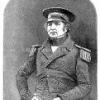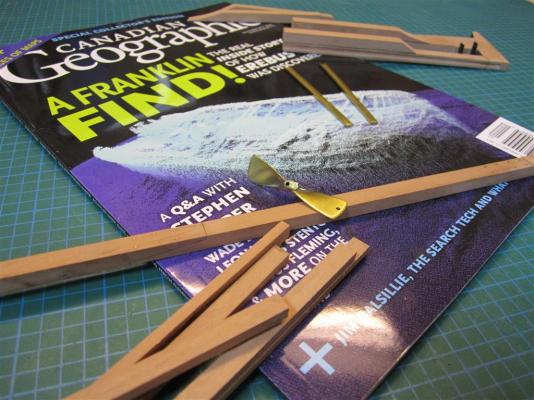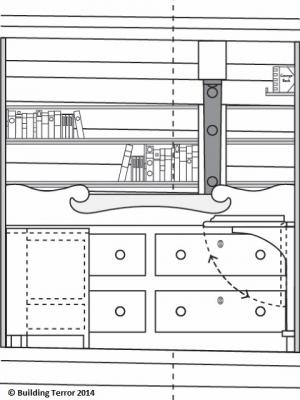-
Posts
410 -
Joined
-
Last visited
Content Type
Profiles
Forums
Gallery
Events
Everything posted by Erebus and Terror
-
"BUILDING HMS TERROR" IN CANADIAN GEOGRAPHIC MAGAZINE The magazine with my own "wreckage" - of soon to be assembled parts. Canadian Geographic just released their special magazine devoted to Parks Canada's discovery of HMS "Erebus". It's a comprehensive issue filled with articles by members of the discovery team and some of the world's foremost Franklin researchers. It also includes some wonderful graphics, including never before seen photographs of the discovery. I'm happy to report that Canadian Geographic asked to use my plans for their article on the ships, and if you buy the magazine you can see a custom version of HMS Terror's outboard profile, which is an updated version of a plan I produced many months ago. They also interviewed me about the model itself and that Q and A can be seen on the digital content for the magazine here: mag.cangeo.ca/dec14/ship (it seems the link isn't live right now but should be soon). P.S. Yes, there is a little progress shown above! The copper scarph bolts are now in place, and I've roughed out the groove for the rudder on the rudder post. I've been working steadily on the bulkhead assembly and hope to show major progress soon.
- 346 replies
-
- terror
- polar exploration
-
(and 2 more)
Tagged with:
-
Inserting find Druxey - here are some copper versions from HMS Investigator, refitted in 1851.
- 1,215 replies
-
- sloop
- kingfisher
-
(and 1 more)
Tagged with:
-
Many thanks for the information, Ed. These ships get more and more interesting...
- 3,618 replies
-
- young america
- clipper
-
(and 1 more)
Tagged with:
-

THE BLACKEN-IT TRIALS
Erebus and Terror replied to Erebus and Terror's topic in Metal Work, Soldering and Metal Fittings
Awful news. I've purchased some Jax, so I'm hoping it works just as well. -
Did these ships ever use iron knees, Ed?
- 3,618 replies
-
- young america
- clipper
-
(and 1 more)
Tagged with:
-

THE BLACKEN-IT TRIALS
Erebus and Terror replied to Erebus and Terror's topic in Metal Work, Soldering and Metal Fittings
Blacken the piece until it is the desired colour, however long it takes. Baking soda bath should not be longer than ten seconds of so. If you are still worried, just rinse in water. -

THE BLACKEN-IT TRIALS
Erebus and Terror replied to Erebus and Terror's topic in Metal Work, Soldering and Metal Fittings
This is horrible news, if true! Blacken it is a staple product and I hope someone can take over the company... -
I like the use of the card, Ed. It looks great. I recently purchased some wonderful black "chalk" cardstock. I plan to experiment with it and see if it might be suitable for molded iron bow plating.
- 3,618 replies
-
- young america
- clipper
-
(and 1 more)
Tagged with:
-

THE BLACKEN-IT TRIALS
Erebus and Terror replied to Erebus and Terror's topic in Metal Work, Soldering and Metal Fittings
Kevin and Bart, thanks for the very helpful information! -
Wow Danny! I really like your use of card rather than metal here - I can't tell the difference between well-blackend brass/copper. You are giving me all sorts of ideas.
-
What a beautiful ship. Your skill, research, and enthusiasm has made me a real fan of the clipper. I had never given them much thought before, but they are marvelous, and so is your model.
- 3,618 replies
-
- young america
- clipper
-
(and 1 more)
Tagged with:
-
Thanks for the posts! I did see this wonderful news. I'm eager to see how close the actual ship matches my plans and model. Hopefully I won't have to change much, and from the images I've seen so far it looks like the plans and model are in great shape. In any case, the exterior is so smashed that my plans will still be of some use. No idea of which ship it is, though, so I wouldn't even want to speculate. Of course, I have hopes. And Druxey - some day I will be as witty as you! Good one!
- 346 replies
-
- terror
- polar exploration
-
(and 2 more)
Tagged with:
-
Thanks for the kind words, Antony. As for a book; I've had quite a few encouraging suggestions along these lines and it's a possibility that's becoming more appealing. But, I haven't published in this particular field before and I haven't approached any publishers yet. I'm not in a particular rush. So, I'm taking it slowly and focusing on building an accurate model for now. More on that soon, I hope.
- 346 replies
-
- terror
- polar exploration
-
(and 2 more)
Tagged with:
-
Oh, it's severe and chronic I'm afraid!
- 346 replies
-
- terror
- polar exploration
-
(and 2 more)
Tagged with:
-
Ha ha! Thanks Druxey...To my shame, I admit I actually considered a couple of the authors (look closely at the section of Irving's cabin).
- 346 replies
-
- terror
- polar exploration
-
(and 2 more)
Tagged with:
-
CAPTAIN CROZIER’S BED CABIN Scale cross section of Crozier's personal quarters (at Station 12). Note that the double planking and ice channels on the hull aren't shown here. As part of my research on the Terror’s lower deck, I created a series of elevations of the fittings and accommodations. In my previous post, I provided a cross section of the captain’s great cabin, which was the most spacious and lavishly appointed room on the ship. This stood in contrast to Crozier’s bed cabin which appears to have been as small and spare as the other officer cabins (in fact, it was among the smaller bed cabins on the vessel). It had just enough space for a simple bed, a washstand, and a small fixed writing table (in contrast to the larger folding writing tables in the other cabins). This cross section is based on details derived from the Terror’s 1836 lower deck plans (modified in 1845), the somewhat more detailed 1839 lower deck plans, and the 1839 midships section plan. Further information was taken from images of fittings on HMS Unicorn, HMS Trincomalee, and HMS Warrior. The cross section shown here provides some interesting information about how the ship was modified for polar exploration. The square-shaped hot air heating funnel can be seen just behind the bed. Heated air must have escaped from holes in the upper surface of the funnel, rising through the space between the bed and the spirketting caused by the knee, as the 1836 plans (and others) show that these beds were built flush to the deck. The “thick” waterway was fitted in 1836 and, in addition to its traditional function of protecting the beam and plank ends, worked as a sort of reverse shelf piece/deck clamp to support strain on the decks from ice pressure. The six inch thick shelf piece itself was as robust as ships of 60 to 90 guns, and its run and position is specifically noted on both the 1836 and 1839 profile plans, suggesting it was a new modification to both ships. The right-angle iron knee was a relatively standard design of the era and examples can be found on the gun deck of Seppings' HMS Unicorn. We know similar knees were retrofitted to HMS investigator and I expect the same occurred on the Terror, and the partial section on the 1836 plans shows a clamp/shelf design commonly used with iron knees (although the iron knee isn't shown until the 1845 midships section). The knee was bolted to the beam, the bolts passing through the shelf piece, the chock, the frame, and the first layer of the outside hull planking. Uniquely, its heel was supported by a massive six inch thick plank bolted to the spirketting. Again, the run of this plank was shown on both the 1836 and 1839 profile plans, suggesting it was a critical modification to both ships. On the Investigator, both the shelf piece and the supporting plank below the chock were made from elm, but Rice (Ross 1847) indicates they were made of oak on the Franklin vessels . The massive knees severely impacted the available space in the cabins, and the iron knee itself must have been a constant source of discomfort to Crozier’s sleep. In a personal letter to his friend and former commander, James Clark Ross, Crozier admitted his misgivings about the expedition and confided his deep loneliness. As I developed these plans, I repeatedly pictured Crozier writing alone in his uncomfortable little cabin, the most probable place for him to put down a very private last letter to his best friend. References: Ross, Sir James Clark 1847 A Voyage of Discovery and Research in the Southern and Antarctic Regions, During the Years 1839-1843: Volume I. John Murray, London.
- 346 replies
-
- terror
- polar exploration
-
(and 2 more)
Tagged with:
-
Matt, Michael, and Mark, thank you sincerely for your comments. They are a great source of motivation. Hopefully more soon!
- 346 replies
-
- terror
- polar exploration
-
(and 2 more)
Tagged with:
-

THE BLACKEN-IT TRIALS
Erebus and Terror replied to Erebus and Terror's topic in Metal Work, Soldering and Metal Fittings
Looks like your perseverance paid off! It's a nice deep black with good highlights. I think it will look far better than a painted version. Thanks for posting this here. Blackening metal seems to be one of the arcane arts, and I've yet to master it. -
Thank you for all of the likes and comments. They are much appreciated. And hlipplaa, I agree she was an awesome ship. One of the great exploration vessels...
- 346 replies
-
- terror
- polar exploration
-
(and 2 more)
Tagged with:
-
A VIEW FROM HMS TERROR’S LOWER DECK Starboard cabin arrangement HMS Terror, 1845 (Note: cabin of Thomas Johnson open for debate). In late May I began a new sub-project of my build - creating an accurate plan of HMS Terror’s lower deck. I thought the project would take a few weeks at most, but creating this plan turned out to be a three month ordeal requiring minute scrutiny of multiple plans and significant research on mid-19th century deck furniture and fittings. The task was made easier by Peter Carney and William Battersby who kindly assisted me with translating some annotations on the plans. The difficulty in this project stems from the multiple versions of plans for HMS Terror, some of which are heavily annotated. There are three versions of just the Terror’s lower deck plans, including: 1) the initial 1813 lower deck plan (ZAZ5616), 2) the 1839 plan which shows both HMS Terror and Erebus, and 3) the 1836 plan, which was modified extensively in 1845 (ZAZ5676). In addition, critical information was gleaned from the 1839 midships section plan (ZAZ5678). I began by tracing the 1836 plan, and spent nearly a month interpreting the faint 1845 annotations which outline changes to the position of the cabins and a system of hatches and scuttles to accommodate the new engine room in the hold. I then carefully added information on deck furniture from the 1839 plan, and structural details from the 1813 plans. Finally, I compared the new plans to the inboard profile plans I previously created to ensure the accuracy of both (this indicated that some changes were needed on the inboard profile plans). I also created a series of detailed elevation plans for the crew accommodations and various fittings, some of which I will post over the coming weeks. HMS Investigator plans were very useful in this regard, as they provide important details that are not shown on the Erebus and Terror plans. Additionally, I found critical information on the appearance and construction of deck furniture from researching photos from HMS Unicorn, HMS Trincomalee, and HMS Warrior. Following research outlined in previous blog posts, I assume that most of HMS Terror’s 1845 fittings conformed to specifications outlined on the 1839 Terror and Erebus plans. Parry’s rationale for identically outfitting polar expeditions notwithstanding, I believe the Admiralty learned important lessons from the near- disastrous 1836 Back expedition (see a description of the damage to the ship here), and decided that critical structural improvements were necessary for all arctic bomb-discovery vessels. Thus, the 1839 plans are titled “Terror and Erebus as Fitted” because both ships were meant to be outfitted to precisely the same standards. These new systems proved themselves in the highly successful antarctic expedition, and by the time they sailed north in 1845, further improvements meant that both ships represented the state of the art in nautical science. While the project took far longer than anticipated, I greatly enjoyed producing these plans, as they provide insights into what the long winters in the ice were like for Crozier and his crew, nearly 170 years ago. Indeed, the ability to put a name to a specific cabin was a moving revelation; for example, Lieutenant Irving's description of the “dreadful puffings and screamings” of the locomotive engine (Bell 1881: 117) takes on new meaning when one realizes his cabin was almost directly above it! References: Bell, Benjamin 1881 Lieut. John Irving, R.N. of H.M.S. "Terror" in Sir John Franklin's Last Expedition to the Arctic Regions: A Memorial Sketch With Letters. D. Douglas, Edinburgh. Lower Deck, HMS Terror, 1845 (note the presence of the large central sail bin on Terror, needed to accommodate the creation of the engine room in the orlop deck and hold). Port cabin arrangement, HMS Terror, 1845 (Note: cabin of John Lane open for debate). Captain's cabin, HMS Terror, 1845, facing aft (note the panels covering the central propeller well and the drawers below). Lieutenant John Irving's cabin (the line is station 8), facing port (note the iron knee, bookshelves, and folding table).
- 346 replies
-
- terror
- polar exploration
-
(and 2 more)
Tagged with:
-
I'm amazed at your progress, Ed. And with that superb level of craftsmanship - it's truly impressive.
- 3,618 replies
-
- young america
- clipper
-
(and 1 more)
Tagged with:
-

THE BLACKEN-IT TRIALS
Erebus and Terror replied to Erebus and Terror's topic in Metal Work, Soldering and Metal Fittings
Actually I just checked another post that mentioned ongoing corrosion. To my surprise he used K&S brass as well! So, I think we have our answer to the corrosion problem. Can anyone recommend another hobby brass supplier? Recommendation: Don't use Blacken-It on K&S brass!
About us
Modelshipworld - Advancing Ship Modeling through Research
SSL Secured
Your security is important for us so this Website is SSL-Secured
NRG Mailing Address
Nautical Research Guild
237 South Lincoln Street
Westmont IL, 60559-1917
Model Ship World ® and the MSW logo are Registered Trademarks, and belong to the Nautical Research Guild (United States Patent and Trademark Office: No. 6,929,264 & No. 6,929,274, registered Dec. 20, 2022)
Helpful Links
About the NRG
If you enjoy building ship models that are historically accurate as well as beautiful, then The Nautical Research Guild (NRG) is just right for you.
The Guild is a non-profit educational organization whose mission is to “Advance Ship Modeling Through Research”. We provide support to our members in their efforts to raise the quality of their model ships.
The Nautical Research Guild has published our world-renowned quarterly magazine, The Nautical Research Journal, since 1955. The pages of the Journal are full of articles by accomplished ship modelers who show you how they create those exquisite details on their models, and by maritime historians who show you the correct details to build. The Journal is available in both print and digital editions. Go to the NRG web site (www.thenrg.org) to download a complimentary digital copy of the Journal. The NRG also publishes plan sets, books and compilations of back issues of the Journal and the former Ships in Scale and Model Ship Builder magazines.








